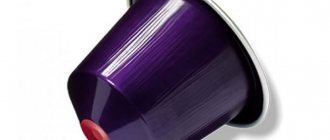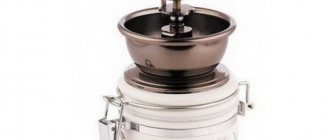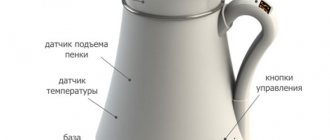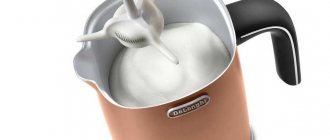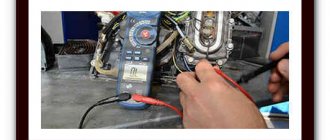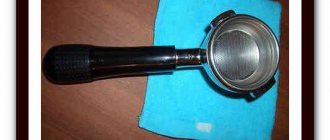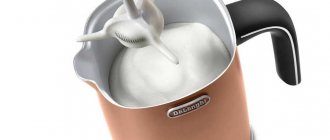The amazing popularity of Nespresso in European and CIS countries gives rise to the question of what is the main advantage of these coffee machines and coffee compared to their competitors. We would like to look into this issue as objectively as possible (we are promoting Lavazza, Nespresso’s main competitor in the capsule segment). They will return to the roots, talk about the Nestle product family and show all the advantages and disadvantages of Nespresso.
How and where did Nespresso come from? What are they?
As you all know, Nesspresso is one of the divisions of Nestle. But at the same time it is a completely independent direction, with its own headquarters in Switzerland, plans and distribution strategy. The first attempts to enter the market were made by Jean-Paul Gaillard in 1986, although according to the company itself, already in 1976, Eric Favre developed a system for capsule coffee preparation that is known to everyone today. At the time of launch, a positioning model was destined - a club system, without membership in which you could not become the owner of a wonderful coffee maker. So Nespresso singled out a market segment in which there were no competitors, which became (as it now turns out) one of the highest-margin areas in the coffee business. It seems to us that the company began with the following judgment: “The client should feel privileged, belonging to a narrow circle of clients, he should be able to feel involved in something
high and inaccessible to other clients,” while pricing is understandable for people with average incomes, which forms the mass market in Europe. From this point on, Nespresso began to pursue its consistent strategy of creating a luxury image in the eyes of the consumer. Below is a graph showing the values and segment that Nespresso has occupied (based on our internal understanding of the situation).
Benefits of Nespresso capsules
- Each capsule contains enough coffee for one serving.
- It only takes 30 seconds to prepare coffee capsules.
- The coffee beans are perfectly roasted, which is reflected in the aroma and taste.
- The resulting drink has an ideal consistency and thick foam.
- Capsule coffee has a rich assortment of flavors.
- Vacuum packaging allows you to preserve the freshness of the product and taste characteristics for a long time.
- The capsules are reasonably priced.
Brand Communication
At the beginning of its journey Nespresso
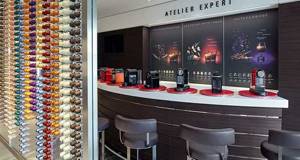
They relied on the club being closed. So the concept of distribution was radically different from the concept of today. The company did not have boutiques and did not communicate with consumers in mass marketing language. As a result, the company's expectations were not met, the brand's popularity did not reach the required levels, and the financial situation pushed top management to large-scale changes. And in 2000, the company's first boutique opened in Paris. Nespresso began to use celebrities in its communication strategy, using their image and positive attitude to create a luxury image in the eyes of the consumer. Nespresso chose the best of the best and attracted George Clooney, Penelope Cruz, Johnny Depp in the image of the Hatter from Alice in Wonderland to their advertising companies.
Nespresso product family
Nestle is achieving success in the luxury segment, but what to do with those who are not ready to overpay for a picture, but are not averse to trying capsule coffee. As part of business diversification and gaining a large market share in the office and home consumption segment, in 2006 Nestle launched another capsule line, now this is a retail line - Dolce Gusto. Unlike Nespresso, the model here is different. The product reaches retailers' shelves, thereby expanding the contact area with the consumer. The customer can buy a coffee machine and coffee in every supermarket. Pricing fits into the model of spontaneous purchasing decisions, because coffee machines are sold almost at cost (~$50). But what can attract attention, and here Nestle also finds a way out. In cooperation with the company Krups, which at that time was already the main manufacturer of coffee machines for Nespresso, they developed daring, hitherto unprecedented coffee machine designs. This move immediately attracts the consumer’s attention to your product. The company is beginning to scale by leaps and bounds. Today, Dolce Gusto is the leader in quantitative terms in the sale of capsules in Europe. And so, Nestle is closing two main consumer segments in Europe. What is the situation with the promising and huge North American market? Having studied the market and tried a strategy that brought success in Europe, Nespresso is faced with the mentality and culture of coffee consumption in America, which is strikingly different from European preferences. Americans mostly consume coffee in large portions, which Nespresso's previously created coffee machines are not designed for. After analyzing the US and Canadian market leader *Keurig, the company realized that their coffee machines and capsule coffee were not able to satisfy the preferences of American customers. Coffee machines are good at preparing a short drink of 30-60 ml, with a rich and dense body in the allotted 20-30 seconds. When I tried to prepare a drink of 200-300 ml of coffee, the coffee turned out hollow, unsaturated, and most importantly, it took more than 2 minutes. So the leader of the luxury segment is thinking about adapting to local peculiarities and already in 2014 they launched the Nespresso VertuoLine system. This is a line of new coffee machines and capsules with a large volume of coffee for comfortable and high-quality preparation of long drinks. Let us remind you that standard Nespresso capsules contain from 5 to 5.5 g of coffee. *Digression:
Keurig was founded in 1998 and is the North American market leader in the OCS (office coffee machines) and home consumption segment. More than 3,000,000 coffee machines sold. The company patented a closed K-cup system, the main difference of which was a large amount of coffee (from 12 to 16 g), coarse grinding and the ability to quickly prepare long drinks.
What is the difference between Nespresso and Dolce Gusto? Let's find out!
The range of capsule coffee machines and capsules on the market sometimes creates real confusion in the purchasing decision-making process. For many owners, not only future ones, but those already using a certain capsule coffee machine, it often comes as a surprise that capsules from a certain type of machine are not compatible with machines of another type. And although coffee from a capsule won’t surprise anyone abroad—capsule machines became quite widespread there back in the 1980s—for residents of Russia and the CIS countries, such coffee machines are still a novelty. On the Russian market, capsule coffee machines are represented mainly by four brands: Nespresso, Dolce Gusto, Tassimo and Cremesso. In this article we will talk about the first two types, because... It is capsules for Nespresso and capsules for Dolce Gusto that you can buy in our store.
Advantages and disadvantages of Nespresso.
In this section we will describe (we want to emphasize - in our subjective opinion) the advantages and disadvantages of the Nespresso system in the realities of the Ukrainian and CIS markets.
Advantages
- We consider the main advantage to be the brand’s image. After all, it’s not in vain that Nespresso pours hundreds of millions into advertising campaigns, so that even the Ukrainian consumer, without having an official representative office in the country, knows the brand, and most importantly, strives to become the owner of coffee equipment and accessories.
- Next, we still want to note the smart design, functionality and range of coffee machines. It is clear that there is no need to compare them with Lavazza Classy range models, but still the guys know a lot about engineering developments.
- If there were Nespresso boutiques in Ukraine, we would, of course, pay attention to this. After all, the atmosphere that reigns in an expensive and beautiful store makes millions of people visit the offline store and stand in an electronic queue to buy coffee machines, accessories and Nespresso coffee capsules.
You can BUY NESPRESSO COFFEE MACHINES AND COFFEE in our online store
As for the shortcomings.
Adherents of the brand will most likely be skeptical))), because we, the authors of this article, popularize and promote brands and services that fiercely compete with Nespresso in Europe - Massimo, Lavazza, illy, Kimbo. But we will still try to be as objective as possible.
- We consider the most important thing to be the amount of coffee in the capsule. A Nespresso capsule contains 5.5 grams of product (for example, Lavazza contains 8.5 g). This has a very strong effect when preparing drinks with a volume of over 50 ml. In such cases, coffee machines produce unsaturated coffee with a loose body.
- Possibility of preparing long drinks with coffee machines. If you drink espresso, everything is fine, but if you still want a larger drink, you will have difficulties. The coffee machine is adapted for preparing a short drink. It presses out a large amount of water for an extremely long time, which in turn leads to the effect of burning the coffee (when the coffee releases a much larger amount of caffeine than necessary and chemicals that form a bitter aftertaste and completely kill the delicate aroma of the drink). In simple terms, use if you only drink espresso.
- High price of capsules. It’s unlikely to be found cheaper than 15 UAH per capsule. Although we, in comparison, wonder why? Lavazza, a world-famous brand with a coffee history of more than 120 years, with technology and culture honed over centuries, sells 8.5 g coffee capsules (Nespresso - 5.5) for half the price.
- If we talk about Ukraine, this is, of course, the lack of official representation. This does not make it possible to buy a product of guaranteed quality and repair the coffee machine in case of breakdown.
- In addition to the expensive price of capsules, you need to buy a coffee machine. Many companies, including Lavazza, provide these coffee machines for free use, provide regular service, exchange them for a new model when they become available, and deliver free coffee.
As for the conclusions. There won't be any)). After reading it, each one will have their own personality. We are glad that you and other readers are looking for information about coffee, drawing it from a variety of sources, trying to understand all the secrets of this wonderful drink and learn more about how to prepare it. This suggests that the level of coffee consumption culture in our country is growing, there is progress, which means we are all on the right path. If, after reading this article, you are deciding whether to give preference to the capsule option for making coffee. The answer is unequivocal - YES. Which brand or company to choose is all very subjective here. Try coffee, test coffee machines and make the right choice. Of course, we recommend that all capsule coffee connoisseurs familiarize themselves with the services of our company Coffice. We have been engaged in this area for more than 7 years, more than 6,000 satisfied customers throughout Ukraine, coffee machines that we provide exclusively for free use and the largest range of capsule coffee brands Massimo, Lavazza, illy, Kimbo will satisfy the desires of the most skilled coffee lovers.
Coffee capsules: the end of the Nespresso monopoly
Actually, we wanted to write an article about how coffee capsules came to be, but we thought about it and decided that it was too boring. Much more interesting is what happened to the capsules next.

Looking for the target audience
When Swedish engineer Eric Favre came up with the idea of creating coffee capsules in the mid-70s, it seemed strange to everyone, including, probably, himself. But Eric was a smart man and immediately hedged his bets - in 1978 he patented his invention. And this made the Nestle company, where Mr. Favre worked, rich for many years. Or rather, not even Nestle itself, but its “daughter” Nespresso.
However, everything started out rather sluggishly.
The owners of cafes and offices, which Nespresso products were initially aimed at, did not really understand why they needed to buy this new equipment for capsules, which constantly required expensive consumables.
And yet, and yet...
In the advertising department of Nespresso there were real geniuses of their craft who managed to create a real aura of elitism and involvement in the high world of financial wealth around capsule machines.
Slowly and gradually, capsule coffee machines began to penetrate... no, not into offices at all, as was originally planned, but into the private homes of wealthy people who value their time and spare money for prestigious coffee.
These are the people who ultimately turned out to be Nespresso’s target audience.

Nespresso's Golden Decade
By the mid-2000s, the company had already firmly occupied its niche in the world market, supplying its products not only to Europe, but also to America. In Russia, of course, there were also connoisseurs of this method of preparing coffee, because despite its shortcomings (price and quality), it has many positive aspects: a quick and simple method of preparation (even a child can do it), a minimum of effort in cleaning the machine (the used capsule is thrown away ), a large selection of different flavors and types of coffee (from classic to complex blends).
Coffee capsules Coffesso “Coffee set”, assorted for Nespresso coffee machine, 50 capsules -25%
961 rub. 1281 rub.
Coffee capsules Coffesso “Espresso Superiore”, for Nespresso coffee machine, 10 capsules -25%
212 rub. 282 rub.
Coffee capsules Coffesso “Classico Italiano”, for Nespresso coffee machine, 10 capsules -25%
212 rub. 282 rub.
Coffee capsules Coffesso “Crema Delicato”, for Nespresso coffee machine, 10 capsules -25%
212 rub. 282 rub.
Coffee capsules Live coffee “Ethiopia Sidamo”, for Nespresso coffee machine, 10 capsules 199 rub.
Coffee capsules for Nespresso Don Cortez “Dolce” coffee machines, 10 pcs. 230 rub.
Coffee capsules Veronese “Espresso”, for Nespresso coffee machine, 10 capsules 169 rub.
Coffee capsules Live coffee “Colombia Bogota”, for Nespresso coffee machine, 50 capsules 814 rub.
View all coffee capsules
By this point, the project began to bring good profits: it’s no joke, having bought a very inexpensive coffee machine, its owner actually signed an agreement to constantly purchase very expensive capsules (today their cost averages from 30 to 50 rubles per 1 capsule).
And if in 2010 sales of coffee capsules accounted for about 20% of the total turnover of ground coffee, then by 2015 they reached a point above 60%.
It would seem that the time has come for Nespresso owners to joyfully clap their hands and reap the fruits of their foresight, but... the simple logic of supply and demand could not help but introduce new variables into this game. Namely, competitors.
Long live competition!
Yes, Nespresso had a stack of patents for every part of their business, but for every smart head there is always at least one more. In 2011, Jean-Paul Gaillard, the former CEO of Nespresso, founded a rival company, Ethical Coffee Company SA, which began producing compatible, eco-friendly, biodegradable capsules for Nespresso machines.
By pressing on the unethical nature of Nespresso's business (their capsules were not recycled), he became the strongest and most dangerous competitor, but not the only one.
The further we went, the more people appeared who wanted to grab a piece of this pie. Tassimo, Lespresso, Paulig, Lavazza, Coffesso and others today successfully compete with each other, giving customers the opportunity to choose their capsule coffee both by taste and price.

The cost of one capsule for Nespresso today starts from 15 rubles
How did they do it? Sleight of hand and no fraud! At first, Nespresso’s competitors began to use other materials to make their capsules (and assured everyone that their plastic “cups” were no worse than the original aluminum ones), and then the patents began to expire and the Nespresso owners were no longer able to renew them. Numerous lawsuits that Nespresso brought against competitors invariably ended in processes decided in favor of other companies (no patent - no claims, sorry). In 2017, even aluminum “copies” of capsules appeared on the market, which was impossible for a long time.
And especially dedicated fans of capsule coffee have learned how to refill reusable capsules. True, there is almost no benefit from this, and we wrote about this a little earlier.

In an attempt to maintain their monopoly, the owners of Nespresso tried various methods, including trying to change the design of their machines so that no other capsules would fit them. But, in the end, this did not help - capsule coffee burst into the world of mere mortals. The aura of elitism and belonging to a closed bourgeois club has gradually faded: today, any person with an average income can afford a capsule coffee machine. If, of course, he likes the taste of coffee brewed in it.
Do you like capsule coffee? What raw materials do you prefer?
